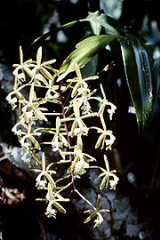
Epidendrum cristatum
Encyclopedia
Epidendrum cristatumRuiz & Pav. (1789) (the "comb Epidendrum") is a species of orchid in the genus Epidendrum
which is known to grow both terrestrially and epiphytically
at altitudes near 1 km in the Neotropics from Mexico
through Brazil
, as well as Trinidad
.
, the stems of E. cristatum are un-swollen and covered by close, tubular sheathes which bear distichous, somewht leaathery, lanceolate leaves (up to 3 cm long by 4 cm wide) on the upper part of the stem. The terminal paniculate
inflorescence grows through several enlarged spathes, arranged in a fan, which cover the peduncle
. The yellow-green flowers often have purple-brown markings. The oblong convex obtuse sepals can grow up to 2.8 cm long, slightly longer than the linear petals. The lip
is adnate to the column
to its apex with a shape that resembles a comb.
The diploid chromosome
number of E. cristatum has been determined as 2n = 40, the haploid chromosome number as n = 20.
Epidendrum
Epidendrum , abbreviated Epi in horticultural trade, is a large neotropical genus of the orchid family. With more than 1,100 species, some authors describe it as a mega-genus. The genus name refers to its epiphytic growth habit...
which is known to grow both terrestrially and epiphytically
Epiphyte
An epiphyte is a plant that grows upon another plant non-parasitically or sometimes upon some other object , derives its moisture and nutrients from the air and rain and sometimes from debris accumulating around it, and is found in the temperate zone and in the...
at altitudes near 1 km in the Neotropics from Mexico
Mexico
The United Mexican States , commonly known as Mexico , is a federal constitutional republic in North America. It is bordered on the north by the United States; on the south and west by the Pacific Ocean; on the southeast by Guatemala, Belize, and the Caribbean Sea; and on the east by the Gulf of...
through Brazil
Brazil
Brazil , officially the Federative Republic of Brazil , is the largest country in South America. It is the world's fifth largest country, both by geographical area and by population with over 192 million people...
, as well as Trinidad
Trinidad
Trinidad is the larger and more populous of the two major islands and numerous landforms which make up the island nation of Trinidad and Tobago. It is the southernmost island in the Caribbean and lies just off the northeastern coast of Venezuela. With an area of it is also the fifth largest in...
.
Description
Epidendrum cristaum is an unusually large reed-stemmed Epidendrum, growing up to 8 m tall. As with other members of the subgenus E. subg. SpathiumEpidendrum subg. Spathium
John Lindley published Epidendrum subg. Spathium of the Orchidaceae. According to Lindley's diagnosis,, the E. subg. Spathium is recognizable by is sympodial habit with individual stems being slender and covered by the bases of the distichous leaves, by the lip of the flower being...
, the stems of E. cristatum are un-swollen and covered by close, tubular sheathes which bear distichous, somewht leaathery, lanceolate leaves (up to 3 cm long by 4 cm wide) on the upper part of the stem. The terminal paniculate
Panicle
A panicle is a compound raceme, a loose, much-branched indeterminate inflorescence with pedicellate flowers attached along the secondary branches; in other words, a branched cluster of flowers in which the branches are racemes....
inflorescence grows through several enlarged spathes, arranged in a fan, which cover the peduncle
Peduncle (botany)
In botany, a peduncle is a stem supporting an inflorescence, or after fecundation, an infructescence.The peduncle is a stem, usually green and without leaves, though sometimes colored or supporting small leaves...
. The yellow-green flowers often have purple-brown markings. The oblong convex obtuse sepals can grow up to 2.8 cm long, slightly longer than the linear petals. The lip
Labellum
Labellum is the Latin diminutive of labium, meaning lip. These are anatomical terms used descriptively in biology, for example in Entomology and botany.-Botany:...
is adnate to the column
Column (botany)
The column, or technically the gynostemium, is a reproductive structure that can be found in several plant families: Aristolochiaceae, Orchidaceae, and Stylidiaceae....
to its apex with a shape that resembles a comb.
The diploid chromosome
Chromosome
A chromosome is an organized structure of DNA and protein found in cells. It is a single piece of coiled DNA containing many genes, regulatory elements and other nucleotide sequences. Chromosomes also contain DNA-bound proteins, which serve to package the DNA and control its functions.Chromosomes...
number of E. cristatum has been determined as 2n = 40, the haploid chromosome number as n = 20.

